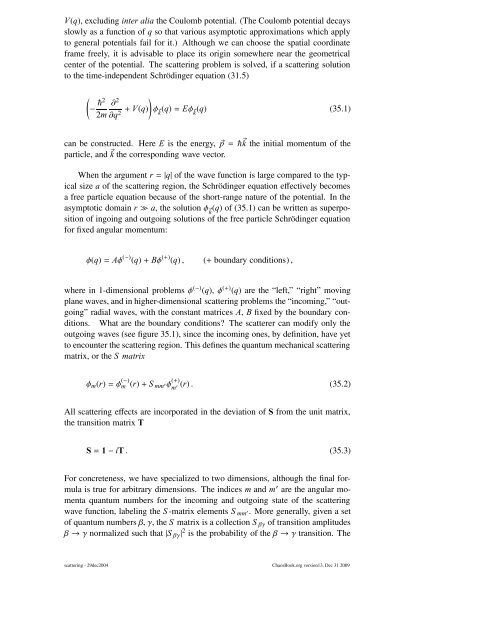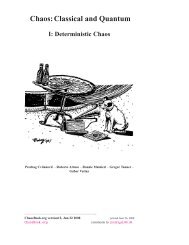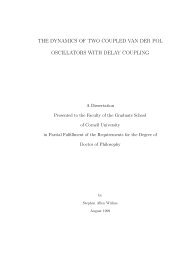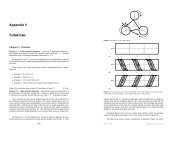Quantum scattering - Chaos: Classical and Quantum
Quantum scattering - Chaos: Classical and Quantum
Quantum scattering - Chaos: Classical and Quantum
You also want an ePaper? Increase the reach of your titles
YUMPU automatically turns print PDFs into web optimized ePapers that Google loves.
V(q), excluding inter alia the Coulomb potential. (The Coulomb potential decays<br />
slowly as a function of q so that various asymptotic approximations which apply<br />
to general potentials fail for it.) Although we can choose the spatial coordinate<br />
frame freely, it is advisable to place its origin somewhere near the geometrical<br />
center of the potential. The <strong>scattering</strong> problem is solved, if a <strong>scattering</strong> solution<br />
to the time-independent Schrödinger equation (31.5)<br />
(− 2<br />
∂ 2 )<br />
2m ∂q 2 + V(q) φ ⃗ k (q) = Eφ (q) (35.1)<br />
⃗k<br />
can be constructed. Here E is the energy, ⃗p = ⃗k the initial momentum of the<br />
particle, <strong>and</strong> ⃗k the corresponding wave vector.<br />
When the argument r = |q| of the wave function is large compared to the typical<br />
size a of the <strong>scattering</strong> region, the Schrödinger equation effectively becomes<br />
a free particle equation because of the short-range nature of the potential. In the<br />
asymptotic domain r ≫ a, the solution φ ⃗ (q) of (35.1) can be written as superposition<br />
of ingoing <strong>and</strong> outgoing solutions of the free particle Schrödinger equation<br />
k<br />
for fixed angular momentum:<br />
φ(q) = Aφ (−) (q) + Bφ (+) (q) , (+ boundary conditions) ,<br />
where in 1-dimensional problems φ (−) (q), φ (+) (q) are the “left,” “right” moving<br />
plane waves, <strong>and</strong> in higher-dimensional <strong>scattering</strong> problems the “incoming,” “outgoing”<br />
radial waves, with the constant matrices A, B fixed by the boundary conditions.<br />
What are the boundary conditions? The scatterer can modify only the<br />
outgoing waves (see figure 35.1), since the incoming ones, by definition, have yet<br />
to encounter the <strong>scattering</strong> region. This defines the quantum mechanical <strong>scattering</strong><br />
matrix, or the S matrix<br />
φ m (r) = φ (−)<br />
m (r) + S mm ′φ (+)<br />
m ′ (r) . (35.2)<br />
All <strong>scattering</strong> effects are incorporated in the deviation of S from the unit matrix,<br />
the transition matrix T<br />
S = 1 − iT . (35.3)<br />
For concreteness, we have specialized to two dimensions, although the final formula<br />
is true for arbitrary dimensions. The indices m <strong>and</strong> m ′ are the angular momenta<br />
quantum numbers for the incoming <strong>and</strong> outgoing state of the <strong>scattering</strong><br />
wave function, labeling the S -matrix elements S mm ′. More generally, given a set<br />
of quantum numbers β, γ, the S matrix is a collection S βγ of transition amplitudes<br />
β → γ normalized such that |S βγ | 2 is the probability of the β → γ transition. The<br />
<strong>scattering</strong> - 29dec2004 <strong>Chaos</strong>Book.org version13, Dec 31 2009









